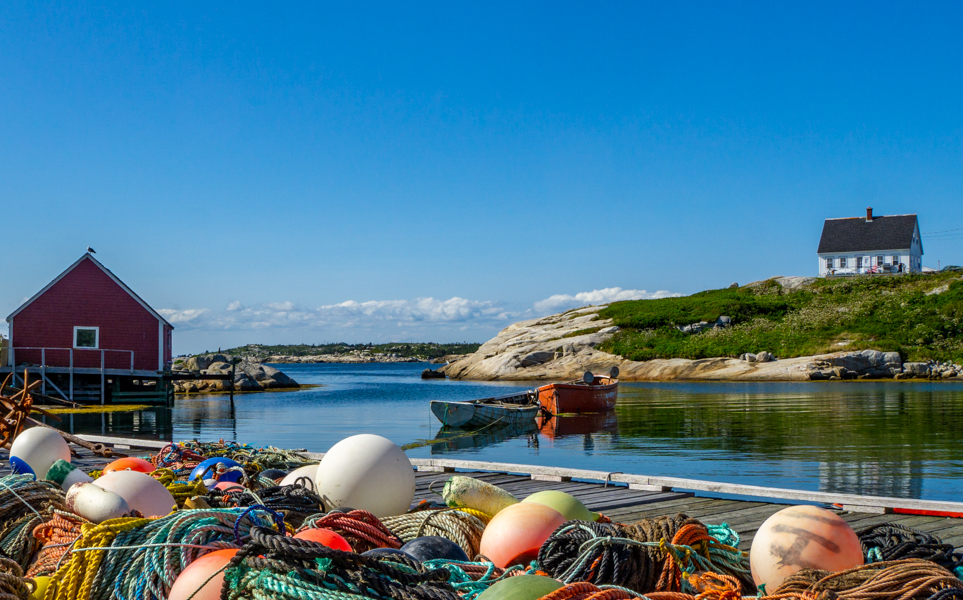Leaving Quebec behind, we made a one day stop in Bathurst, New Brunswick, on our way to Moncton. As a general rule, we only plan to travel about 4-5 hours when pulling the trailer, since we tend to take longer than predicted. This allows us to take our time getting on the road and still arrive early evening. We also try not to travel with the trailer two days in a row, hence the one day break. No need to push…we are retired after all. Bill mapped out a motorcycle ride for us to Miscou Island to see the lighthouse. This lighthouse, built in 1856, is a Canadian National Historic Site and is one of the rare surviving wooden, octagonal, 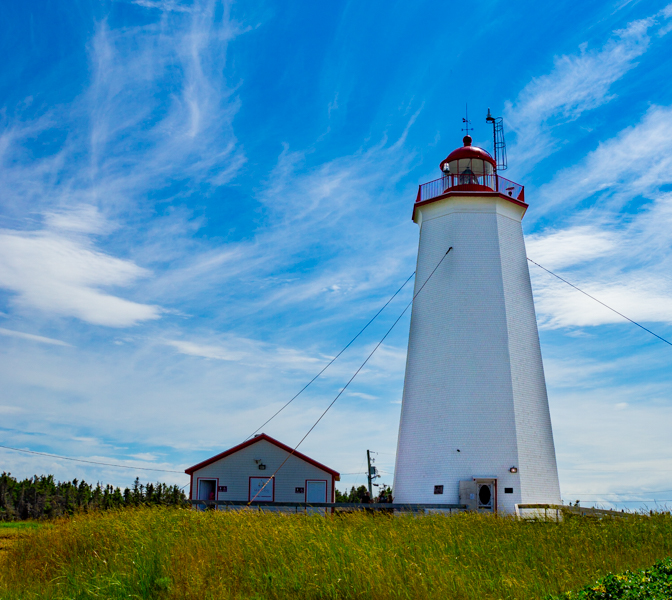 tapered lighthouses. It has a powerful dioptric light and a diaphone fog alarm (go ahead, ask her what that means. I bet she can’t explain it. Neither can I by the way). The lighthouse is still operational and is considered a major coastal aid to navigation. It was less picturesque than we had hoped, as was the ride. We did have some excitement though as Bill ran out of gas out in the middle of nowhere. Fortunately, the house where we coasted to a stop turned out to also be a small engine repair shop so they gave him a gallon of gas (They would have given me the gas but I gave them $20 which was the only Canadian money that I had and thought I got a bargain). Fifteen minutes after we got back on the road we got soaked with a very heavy downpour so we stopped for some hot food before completing the rest of a very cold and wet 90 min drive back to the trailer.
tapered lighthouses. It has a powerful dioptric light and a diaphone fog alarm (go ahead, ask her what that means. I bet she can’t explain it. Neither can I by the way). The lighthouse is still operational and is considered a major coastal aid to navigation. It was less picturesque than we had hoped, as was the ride. We did have some excitement though as Bill ran out of gas out in the middle of nowhere. Fortunately, the house where we coasted to a stop turned out to also be a small engine repair shop so they gave him a gallon of gas (They would have given me the gas but I gave them $20 which was the only Canadian money that I had and thought I got a bargain). Fifteen minutes after we got back on the road we got soaked with a very heavy downpour so we stopped for some hot food before completing the rest of a very cold and wet 90 min drive back to the trailer.
Moncton offered several unique experiences. First up was the World’s Largest Lobster, a 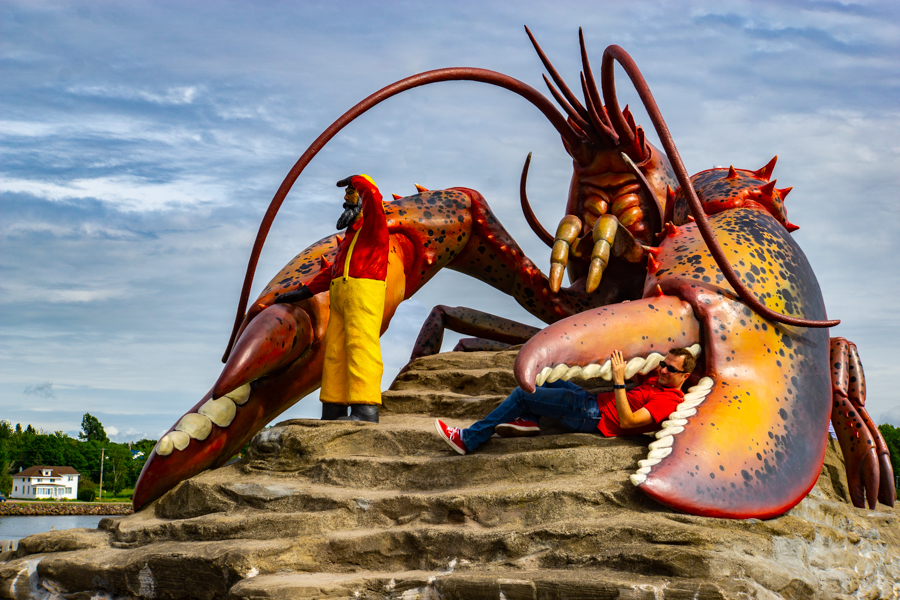 giant statue surrounded by tourist-trap shops. The lobster was crawling with people, both young and old and Bill’s stink eye wasn’t quite working so he didn’t run them all off. We eventually got a few pics without too many strangers.
giant statue surrounded by tourist-trap shops. The lobster was crawling with people, both young and old and Bill’s stink eye wasn’t quite working so he didn’t run them all off. We eventually got a few pics without too many strangers.
A must do is Magnetic Hill (I had visited on a family trip as a boy, let’s call it 45 years ago. At that point it was not commercialized. Now you have to pay the city $6 to drive it and there are several shops, restaurants, hotels, and amusement park, and a mini-golf course, … all tied to the area). To experience Magnetic Hill, you drive your car about 300 yards down a hill, put it in neutral, and it rolls all the way back up the hill. It is said to be a naturally formed optical illusion and you actually drive your car up the hill and simply roll back down. The illusion is very effective and it is definitely worth the $6 fee (it doesn’t really come across in the video so you’ll just have to visit for yourself).
The final oddity is the tidal bore. Fundy Bay is the site of the largest tidal change in the world – roughly 50’. The result of this tide is a wave that travels up the various rivers in the area and in this case, it travels roughly 40 miles to Moncton. Bore View Park was the place to see this phenomenon and they publish a time table of when the wave will pass by. Turns out that the time table isn’t exact as we barely arrived in time to see the wave coming. It was maybe a couple of feet tall on the day of our visit. It is wild to think that the tides rise so much that they can create a wave so far up river. Apparently, the Bore wave can be much higher than what we saw (and filmed) depending on the lunar cycle and we’ve seen video of people surfing it.
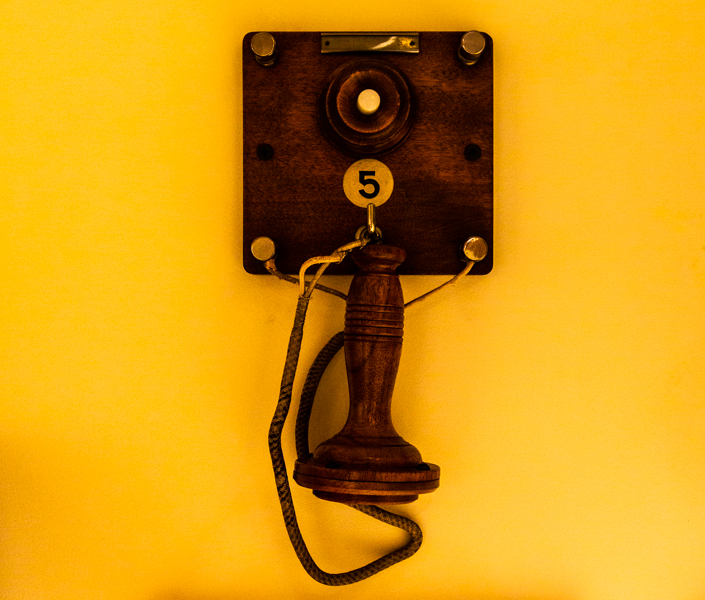
An overnight stop in Baddeck, NS allowed Bill to visit the Alexander Graham Bell Historic Site. I declined this experience, choosing one of my favorite pass-times…relaxing. (I couldn’t miss this given I’d spend my entire career in the telecom industry. Bell wasn’t quite as prolific asEdison but he kept himself busy. He spent time on powered flight, hydrofoils, improving the telephone, including light-wave based transmission. Interestingly, he spent 30 years trying to prove that sheep with multiple nipples are more likely to give birth to twins. Turns out they don’t but he did raise a wonderful flock of sheep with extra nipples. As an aside, there is a new Geico commercial where Bell is at the theater and gets a call from a wrong number. He is #1 and they wanted to call #2. At the museum, they have phone #5.)
Cape Breton Island, Nova Scotia was the most easterly stop on this tour. We started on the west side of the island which is ringed by the Cabot Trail. The trail loops 185 miles around the Northern tip of the island and through the Cape Breton Highlands, and is rated one of the best motorcycle roads in North America. We should have known it would not be a good road for the trailer, but it
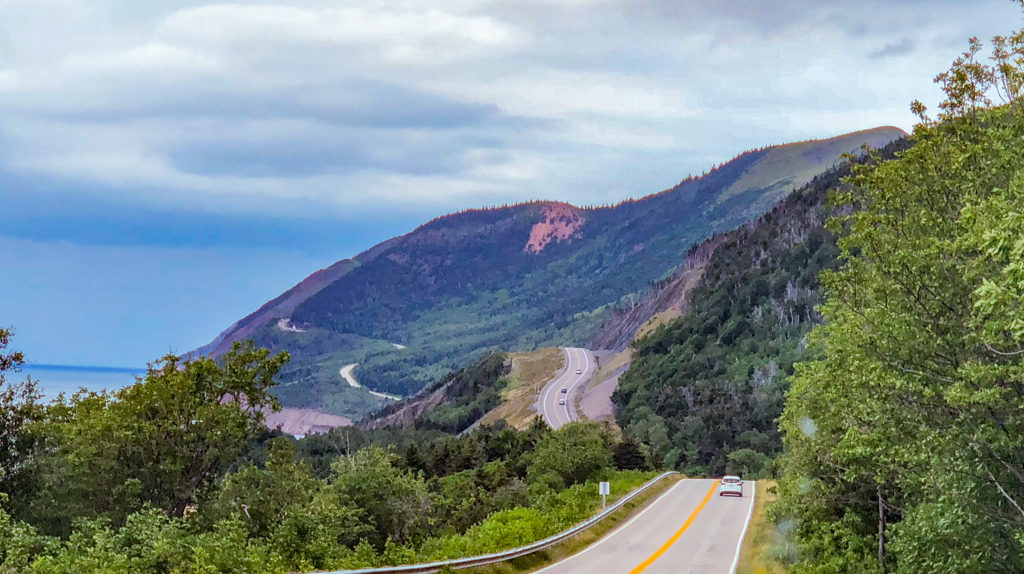
Cape Breton Island
was the ONLY road to get to where we were going, so we had no choice. This was the Canadian scenery I had been expecting, a beautiful coastal road, with mountains, rugged cliffs and dense forest. It was indeed a great motorcycle road, and we spent the next two days riding it. Lots of winding roads up and down the mountains, and perfect temps in the 70’s. When we pulled out of the RV park we were on it, no long freeway ride to get there. The price for that location was driving the trailer on those roads, and the truck got quite a workout, with some concerns about the brakes, but we survived. In spite of the tiny towns here, there were plenty of restaurants where we had good food, and I found another great beer, Keith’s. I would have loved to stay here for another week just to hike and ride…oh well, next time. (Beyond beautiful scenery this area also still has full service gas stations. When we first pulled in and heard that vaguely familiar double bell sound, I was a little surprised. When a woman walked out to pump our gas, I was shocked but happy to oblige.)
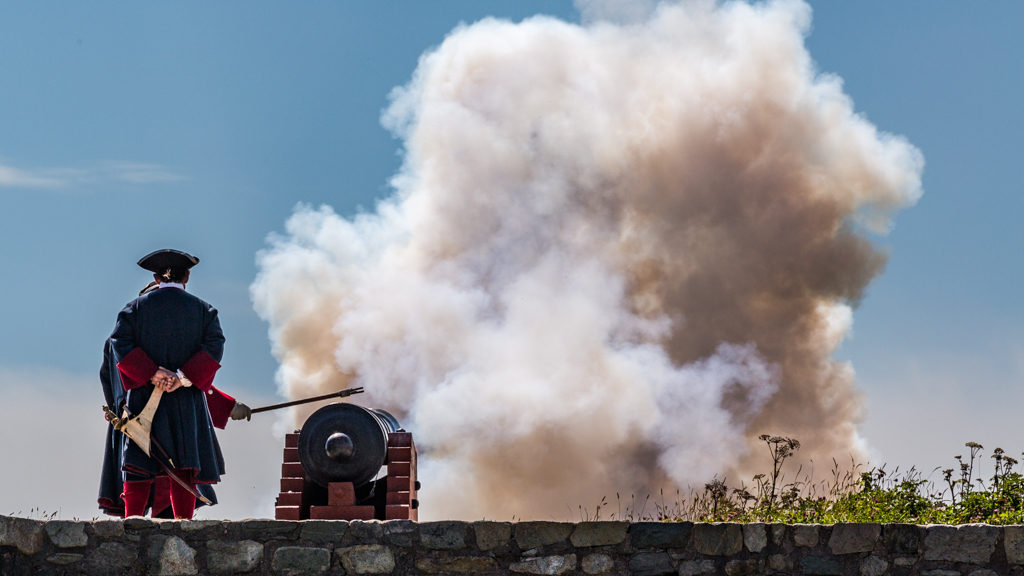
Canons at Fort Louisbourg
Driving to the northeast end of the island, we headed back to the big city, Sydney, Nova Scotia has a population of 31,600 (big is relative around here). Nearby is the Fortress of Louisbourg National Historic Site, which Bill wanted to see. A French fortress, named for Louis XIV, the walls were constructed between 1720 and 1740, making it one of the most extensive (and expensive) European fortifications in North America. It was captured by British colonists in 1745, traded back to the French in exchange for Belgium, and then captured by the British again in 1758. Louisbourg Fortress (a fortified town, as opposed to a fort, which is just a fortified building) was one-quarter reconstructed in 1960’s and 70’s, and it is now the largest reconstruction project in North America. As soon as you enter, everything is true to period, almost 300 years ago, we were greeted by a fisherman, then allowed through the gate by a soldier. We saw the stone bakery where we tried the fresh baked bread (which was still warm and pretty good but quite heavy), the blacksmith where swords were made, the armory where cannon balls were stored, the ice house, barracks, and even ladies tatting lace. We watched them herding sheep (and one of the sheep was pretty unhappy about it) and the shockingly loud and smoky firing of cannons. At the common house, lunch was served by ladies in aprons and caps who provided cloth napkins as big as tablecloths to tie around our necks. They served meat pie, that wasn’t like pie at all, more like turkey and dressing slopped together with bread for $20 bucks each. At least the rum cake was good, although too small for an extra $6 (another failed attempt to discover a pastry that Dessa wouldn’t like).
Bird Island is a large rock about 30 minutes up Big Bras d’Or channel in the open sea of Sydney Bight. It was recommended as the place to see a variety of birds, chiefly Atlantic Puffins, Bald Eagles and Grey Seals. We booked a tour that was designed for photographers (it was billed as a Photographers tour because they took fewer guests but charged each of us a little more. The tour also took place in early evening to provide better light for pictures). Our boat was probably 50 years old, and was captained by a very authentic skinny older man with a full white beard, only missing the pipe. He and his son kept up an interesting historical narrative while at sea, pointing out things to see. Once at the island, we actually found quite a few Bald Eagles, flying overhead and perched on the small rocky ledges. Atlantic Puffins are sort of a cross between a Toucan and a Penguin. They are black and white, with fairly large bright orange beaks (during breeding season) and they dive like ducks for food. They have small 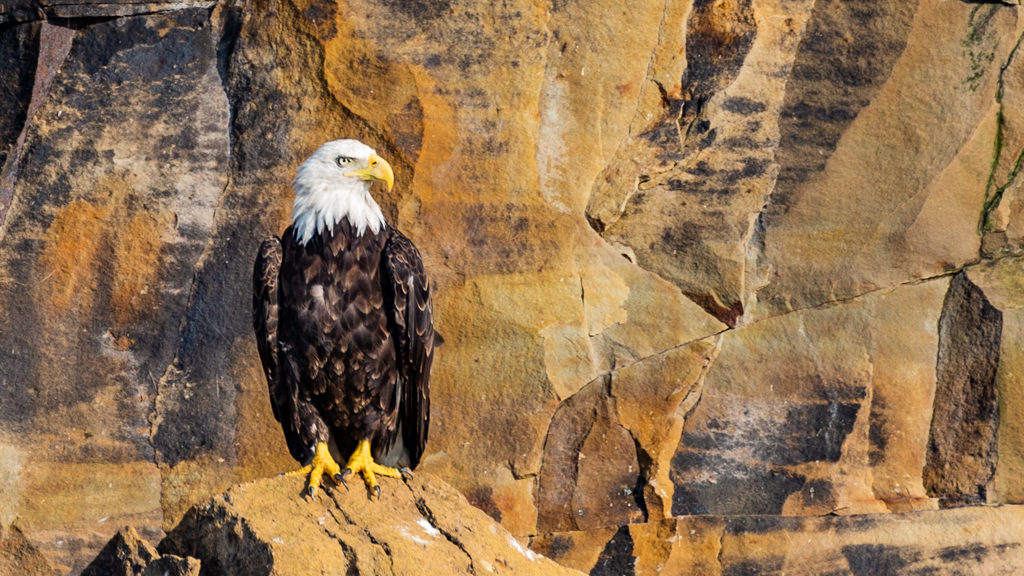 wings, so they flap them around 400 times per minute to take off, then can reach up to 55mph. They were all out in the water, and frequently took flight while we watched. Unfortunately, between the distance, the waves, the rumbling vibrations of the boat engine, and the size of these birds, it was almost impossible to get good pictures (at least with our non-birding equipment). Still I enjoyed seeing the puffins and my first “in the wild” Bald Eagles. We also saw quite a few seals, but they were mostly just heads bobbing in the water. They are such fat blobs (but cute none the less), what a strange animal.
wings, so they flap them around 400 times per minute to take off, then can reach up to 55mph. They were all out in the water, and frequently took flight while we watched. Unfortunately, between the distance, the waves, the rumbling vibrations of the boat engine, and the size of these birds, it was almost impossible to get good pictures (at least with our non-birding equipment). Still I enjoyed seeing the puffins and my first “in the wild” Bald Eagles. We also saw quite a few seals, but they were mostly just heads bobbing in the water. They are such fat blobs (but cute none the less), what a strange animal.
Halifax, the capital of Nova Scotia, really was a bigger town with over 400,000 people. Our campground was challenging to park in (narrow roads and tight turns are not sympatico with a 20’ truck pulling a 45’ trailer), but offered great walking trails where we found lots of chipmunks, bugs and flowers to photograph. The number one thing to do was the Waterfront, but it was too touristy for us. The same old t-shirt / souvenir shops, ice cream and fudge shops, and lots of restaurants. It was a gray day and windy along the boardwalk, and you know you are in Canada in the summer when all the restaurants with patios provide blankets at each chair. We found a bar out of the wind for lunch where we had good beer, seafood, and live music, while watching the swarms of people lining up to buy Cow’s ice cream cones, and the massive container ships sailing by.
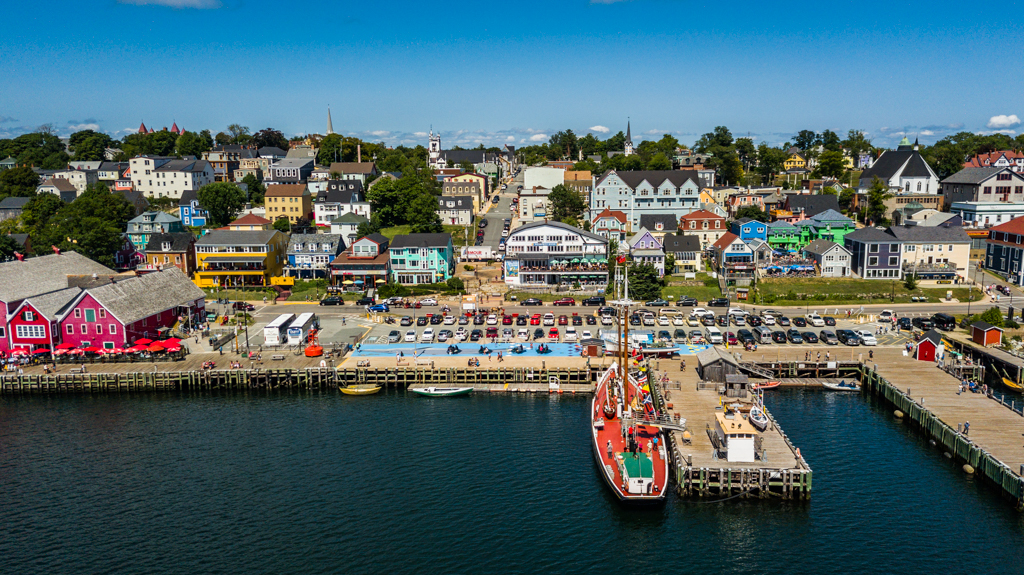
Lunenburg Waterfront
A day trip took us in search of coastal highlights. First stop – Lunenburg, a picturesque fishing village with brightly colored houses converted to shops and restaurants. It is a UNESCO site protecting the architecture of the British colonial settlement, and one of the most photographed towns in Nova Scotia. There was a great memorial to all the seafarers from Lunenburg County who had lost their lives since 1890. The monument is shaped as a compass rose, with eight three-sided columns at each compass point. Inscribed on the black granite columns are the names of mariners, primarily fishermen, who were lost at sea from 1890 until the present. The center stone lists the ships that sank taking all hands-on deck. Most were lost prior to 1925, and it was sad to note how many of them were from the same families. The number of losses has declined dramatically over time to the last ten years where there was only one or two per year. (We stopped for a fish and chip lunch on the patio of the Fish Shack and although it was good and they obviously have access to very fresh fish being located across the street from the dock, it still didn’t compete with The Glen in Ottawa).
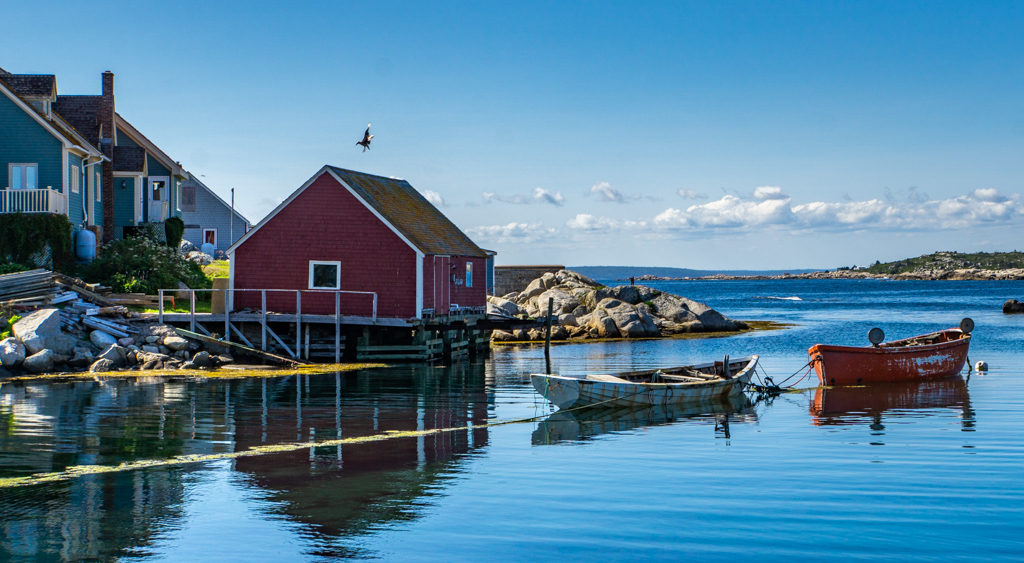
Peggy’s Cove
Second stop – Peggy’s Cove, a rustic, authentic fishing village on St. Margaret’s Bay, home to the Peggy’s Point Lighthouse on a granite outcropping along the rock-strewn shore. It too draws photographers and artists from around the world. Fortunately, we had a beautiful sunny day for picture taking, and Bill was able to get some great shots with his drone. Across the tiny bay is where Swissair Flight 111 crashed in 1998 killing all 229 souls aboard.
Crossing the 8-mile-long Confederation Bridge, our next destination was Cavendish, Prince Edward Island. The entire island is about 100 miles long, mostly farming and fishing communities, and was supposed to be great scenery. We must have missed that area, because we rode the motorcycles from our mid-point campground to the western tip, and it was not very scenic and took forever. We did see several more lighthouses, and finally even one that 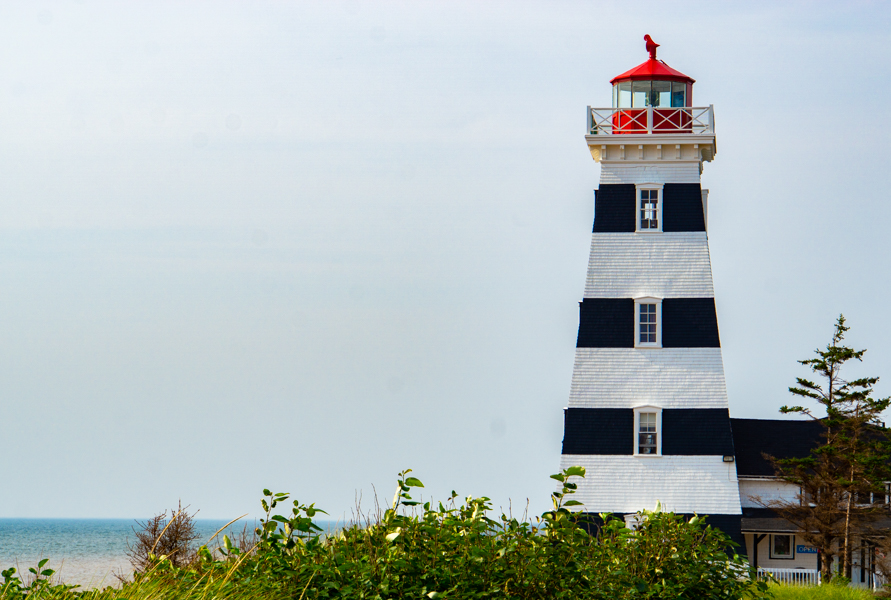 was not the same old white cone with a red top. This one was square with black and white stripes. Our hike was equally nothing special, so we were not very impressed overall, except with the KOA we stayed at, it was great. (To be fair, neither Dessa or I had any interest in the big draw of PEI – Ann of Green Gables. For those of you who have never heard of her, Ann is a bit of a continuing phenomenon in Canada. Much like “Little House on the Prairie” with a bit of Harry Potter, but no magic, obsession thrown in. PEI has another big draw that we did enjoy. This little island supplies 25% of the potatoes to Canada and the french fries we had were some of the best ever).
was not the same old white cone with a red top. This one was square with black and white stripes. Our hike was equally nothing special, so we were not very impressed overall, except with the KOA we stayed at, it was great. (To be fair, neither Dessa or I had any interest in the big draw of PEI – Ann of Green Gables. For those of you who have never heard of her, Ann is a bit of a continuing phenomenon in Canada. Much like “Little House on the Prairie” with a bit of Harry Potter, but no magic, obsession thrown in. PEI has another big draw that we did enjoy. This little island supplies 25% of the potatoes to Canada and the french fries we had were some of the best ever).
Our last stop in Canada was the port city of St. John, New Brunswick on the Bay of Fundy. Our campground was not much to look at but it was located in Rockwood Park which provided some wonderful local hiking. We had great weather, although dense fog seemed to roll in and out at all times of the day. Being actually at the Bay of Fundy we could clearly experience the huge swings in the level of the tide. At low tide we saw boats large and small, still tied up to their dock but sitting on the ground and 100 feet from the nearest water!
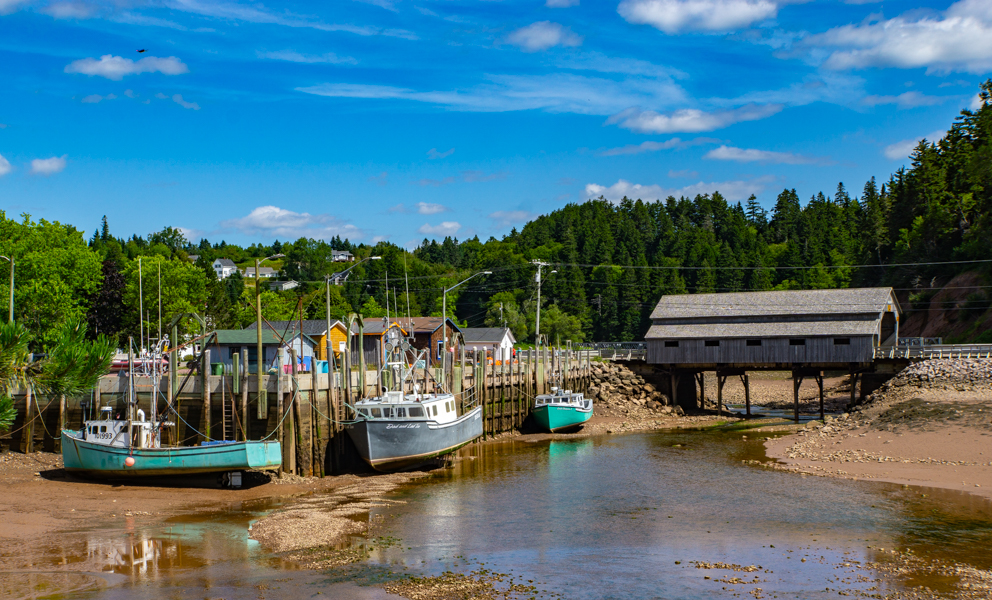
Low Tide
Downtown St. John was nearby so we did one of our city walks which are both fun and educational. St John is the second biggest city in New Brunswick, with a population of 67,000. The area was first settled in the 1600’s, and the British and French fought over the land surrounding it for a century. The town has had its challenges over the years with riots, cholera outbreaks, and a massive fire in 1877 that burned 40% of the town and left 20,000 people homeless.
About an hour away, The Fundy Trail Parkway looked like a great motorcycle ride (and it was). It was a beautiful winding coastal road in perfect condition. We stopped at several of the lookouts, and did short hikes to a couple of small waterfalls. At the end of the 22-mile parkway, we hiked to a gorge where the view consisted of a large sign showing a beautiful panorama with the caption saying “Sky Walk Coming Soon”. Bill put his drone up so we could see some of the gorge and the river at the bottom, but it was definitely not worth the 2-mile round-trip hike.
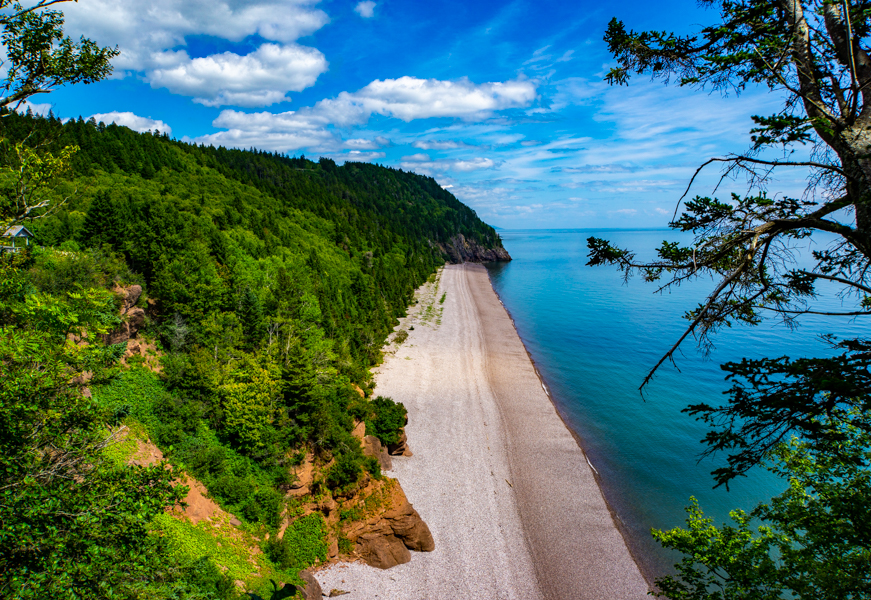
Fundy Trail Parkway
After gearing back up to ride our bikes back to the RV, my bike decided not to start. We were two hours from the RV and at least 30 minutes from any cell service. We asked a couple returning to their car after their hiking for jumper cables and tried in vain to get it started. No such luck. Rather than be left alone in the wilderness, I abandoned the bike and bummed a ride back to the nearest town, half an hour away. It was now 5pm on the Friday of the Labor Day weekend, so no way I could get my bike towed before the park closed at 7pm, and Harley was already closed. The kind strangers dropped me at a restaurant in Saint Martin, where I spent an hour on the phone with Foremost Insurance, while Bill rode the 90 min back to the trailer to get the truck (both of us have single seats on our bikes so no other choice). Foremost struggled, but finally succeeded, to find someone that would agree to drive to the end of the parkway to get my bike, then all the way back to St. John and the RV, on the holiday weekend. Bill finally got back to pick me up after 8pm. Saturday morning, we spent a lovely four hours driving all the way back and forth again to meet the tow truck. Crappy way to end a great ride! There was much more to do in the area, so I am sure we will back someday.
Time to leave Canada in the rear-view mirror, we crossed the border into Maine, leaving the RV in Bangor, and my bike at Harley, to fly home for a week.
… Bill and Dessa
See our pictures and a 2 min video montage here.
